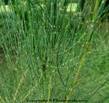| Kingdom | Plantae |
| Division | Gnetophyta |
| Class | Magnoliopsida |
| Order | Ephedrales |
| Family | Ephedraceae |
| Genus | Ephedra |
| Species | E.sinica |
| Binomial name | Ephedra sinica |
Other Common Names:
The other common names for the shrub ephedra are Desert Tea, Ma Huang, Mormon Tea, Squaw Tea, Brigham Tea, American Ephedra, Nevada Joint-Fir, American Ma Huang, Mexican Tea and Desert Ephedra.
History
The Chinese have used ephedra medicinally for over 5,000 years. Ephedra is listed as one of the original 365 herbs from the classical first century A.D. text on Chinese herbalism by Shen Nong.The ephedra - ma huang in the Chinese system of medicine - is a plant which is valued as an herbal remedy.


Description


Range
Ephedra originates in West Central China, Southern Siberia, and Japan. Varieties of the herb are also grown in Europe, India, Australia and Afghanistan.
Habitat
Ephedra grows on the tundra and on the rocky and sandy slopes of Europe, Asia, and America. The plant prefers light sandy and medium loamy soils and requires well-drained soil. It requires dry or moist soil and can tolerate drought.
Cultivation
The Ephedra is robust and doesn't need much attention. Plant the seeds around 20�C (68�F). Grow indoors or in a warm and dry climate, free of frost. It thrives in ordinary loamy soil and does very well in a loose rocky soil with full sun and a little water. It is most often propagated by division of the clumps in spring, and seeds sown in a light sandy soil in early spring. Prick out the seedlings into individual pots as soon as they are large enough to handle and grow them on for at least their first winter in a greenhouse. Plant out in the spring or early summer after the last expected frosts and give some protection in their first winter. The tops of the branches may be picked and dried at any time as long as the plant is not denuded or the branches cut back past the viable buds. To produce seeds masculine as well as feminine plants are needed.
Flowering Season
The flowers of the plant ephedra are in bloom between May through June.
Pests and Diseases
No serious pests or diseases are reported. Leaf spots and powdery mildew are occasionally encountered. Pests at times include aphids which may be the vector for transmitting mosaic virus.
Parts Used

The young stems and branchlets of ephedra are the most commonly used parts of the plant for its medicinal and commercial applications.
Medicinal Applications


• Ephedra is primarily used to treat asthma or bronchitis, ephedra is also prescribed for symptoms of cold and flu including nasal congestion, cough, fever, and chills.
• Ephedra's traditional medicinal uses include the alleviation of sweating, lung and bronchial constriction, and water retention.
• The alkaloids are also effective in treating allergic skin reactions such as hives, relieving general body pain, and treating low blood pressure, rheumatism, and narcolepsy.
• Coughing, shortness of breath, the common cold, and fevers without sweat are all indications for its use.
• Ephedrine and its synthetic counterparts stimulate the central nervous system, dilate the bronchial tubes, elevate blood pressure, and increase heart rate.
• The plant also has antiviral effects, particularly against influenza.
• The stems are also antidote, diaphoretic, diuretic, pectoral, vasoconstrictor and vasodilator.
• It can be used in the treatment of emphysema, in treating whooping cough, and in treating many other severe chest conditions affecting children and adults.
• Ephedra had been sold commercially as an energy-booster, weight-loss supplement, and athletic performance enhancer.

American Ephedra, native to the dry southwest, was used as tea by the early settlers, and was known as "Mormon tea" and "Squaw tea."Ephedra roots can be turned into an herbal decoction, in the Chinese system of medicine; this herbal decoction is used to restore the yin or qi-energy- when weakness in this internal energy begins to induce uncontrolled perspiration in the patient. The promotion of mental calmness and concentration during the meditation period of Zen monks was traditionally aided by doses of the ephedra plant. It is the soma plant of Indo-Iranian religion.